This was published 2 years ago
Revealed: the letter that Scott Morrison ignored that foresaw the teal wave
Thirteen moderate Liberal MPs wrote to Scott Morrison with two simple demands. Seven of them no longer sit in parliament.
By Peter Hartcher and James Massola
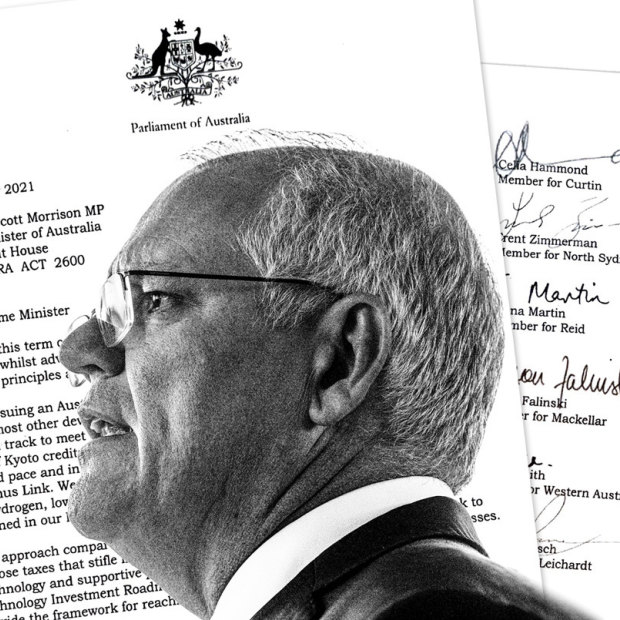
The letter the prime minister, Scott Morrison, did not respond to.Credit: SMH
It was probably the Morrison government’s last chance to hold the Liberals’ traditional blue-ribbon seats, to forestall the teal revolution. The Glasgow climate change conference was approaching. More than a dozen moderate Liberal MPs got together to appeal to their leader to update Australia’s greenhouse emissions pledges.
First in a Zoom meeting with Morrison and later in a letter to him, the moderates told the PM that climate change was the make-or-break question for their electorates: “The message was uniform – ‘Our electorates are not interested in hearing from us unless we address this issue – they will write us off entirely and not listen to us on anything else’,” summarises the moderate who convened the group, Dave Sharma, then-Liberal MP for the Sydney seat of Wentworth, formerly held by Malcolm Turnbull. They demanded two changes. One was to pledge net zero emissions by 2050. The other was to upgrade Tony Abbott’s 2030 emissions target.
Morrison told them he was working on it. And he did deliver the first, but not the second. It was not enough.
The last-ditch letter was delivered to Morrison in October 2021, two weeks before the COP26 convention in Glasgow. It was signed by 13 Liberals. He implored them to keep it secret. They did, until today. He never wrote back – even as the Coalition’s climate deniers and coal promoters noisily banged their campaign drums and gongs to block any progress.
The teals were unstoppably energised. Of the 13 Liberals, six lost their seats at the election. A seventh retired from parliament and Labor won the seat. It was a matter of the utmost frustration.
Sharma and his colleagues put much of the blame on their factional leaders – the “generals” of the moderate faction, Marise Payne, Simon Birmingham and Paul Fletcher.
“Moderates put Morrison into the prime ministership – they should have had a mortgage on it,” Sharma argues. “But I was always struck by the reticence of the moderates’ leadership to get their voice heard and their demands listened to.”
Payne, Birmingham and Fletcher “were intimidated by Scott Morrison. They called him ‘the boss’. He was not. He’s a colleague. The moderate leadership prioritised their relationship with Morrison over getting anything done for us. ” None of the three put their names to the letter of last resort.
Why Morrison’s insistence on secrecy? “He was concerned it would be leaked and weaponised,” reports Sharma. “His attitude was, ‘the more you guys talk about this publicly, the harder it is for us to do this’.
“But the Nationals were never restrained. We [moderates] wanted the outcome, we needed a few plaudits. We were good team players and supported the PM, rather than getting names for ourselves.”
“The moderates do need to speak up,” concludes Sharma. “We need to be clear about our red lines, non-negotiable demands.”
His chagrin uncannily echoes the regrets of the moderates of three years earlier, when Malcolm Turnbull was torn down without having delivered key moderate demands. “We shouldn’t have agreed” with the Nationals, “we should have pushed back”, Birmingham told this masthead at the time. “The high-risk approach – did the Nats have the guts to walk away from the Coalition?”
Today, Birmingham says: “The internal process to achieve the net zero commitment was hard fought. In an own goal, the resistance from some parts of the Coalition was so strong and aired so publicly as to negate much of the impact of this important policy shift.” Payne says she had a strong working relationship with Morrison and “it’s a rather inconvenient truth that Australia, while not doubting it can be more ambitious, consistently outperforms other OECD nations on actual climate change outcomes.”
Yet once again, the moderates played nice and were crushed; once again, the Nats and conservative Liberals had their way; and once again, climate change was the key issue.
More action on climate would not have halted the teal movement, but it might have blunted it. “We had a sincerity deficit on this issue,” concludes Sharma. “Hard to overcome, but this would have helped.”
But it was too late for Sharma. Of the 13 represented on the letter, his was one of the seven seats lost, four to teals and three to Labor. The Morrison government’s failure to act more convincingly on emissions – or even sound like it cared – recruited high-quality candidates to the teal movement and ever more votes for them, which was destroying the structural foundations of the Liberal Party.
It was losing its moderate, or liberal, support base as it favoured its conservatives and populist right wing. Week by week, month by month, the teal revolution was gathering force.
In the blue-ribbon Liberal turf of Western Australia’s electorate of Curtin, previously Julie Bishop’s seat, a community group approached Kate Chaney. Chaney’s surname was synonymous with the Liberals and big business. Her uncle, Fred Chaney, was a former deputy leader of the party and her father, Michael Chaney, was chair of Wesfarmers and formerly of the National Australia Bank and Woodside.
Would she stand against the local member, Liberal Celia Hammond? Kate Chaney felt sick at the idea. The lawyer and business manager was not considering politics. Until she was.
“I felt like vomiting,” Chaney recalls. “But I thought, ‘if I’m not going to do it, who is?’ There was deep dissatisfaction with stalling on climate action, on the energy transition, stalling on economic reform, a focus on politics rather than policy. And integrity in government is an issue that underpins everything. I realised the cavalry is not coming.”
Morrison went to the major climate convention in Glasgow, COP26, in November 2021. His refusal to upgrade Tony Abbott’s pledge on the emissions target for 2030 horrified Chaney. And her daughter.
The 11-year-old was central to her mother’s decision to stand. Chaney relates that when she asked her daughter’s opinion, the girl told her mum: “I think this will be bad for me in the short term because I will miss you, but in the long term you should do it because it will be good for Australia.”
Climate change was probably uppermost in her mind, says Chaney, “as it certainly is among kids her age”.
Curtin had been Liberal for almost the entire 70 years of its existence. Chaney won the seat with a swing against the Liberals of 12 per cent, double the national average.
On the other side of the continent, Monique Ryan had a similar reaction to Morrison’s Glasgow effort. The director of the neurology department at the Royal Children’s Hospital in Melbourne had lived for 15 years in the electorate of Kooyong, the seat of Bob Menzies and Josh Frydenberg.
“The burning issue for me was climate change and anger at Glasgow and the fact that the government had embarrassed Australia on the world stage,” Ryan says. “It was an appalling act, wilfully irresponsible. I have a 13-year-old son who was deeply distressed about climate change. I thought I wasn’t doing enough about it, and regaining a sense of agency would be helpful.”

Monique Ryan now sits in the parliament as a teal independent, representing Josh Frydenberg’s former seat of Kooyong in Victoria. Credit: Kristoffer Paulsen
Ryan simulates an exchange with her boy: “What are you doing about climate change, Mum, other than giving money to ACF and Greenpeace?” Her answer: “Not much.”
There were other motivating factors, including the need for an anti-corruption agency – “the issue inched up and it felt increasingly grubby” – and the pace of the vaccine rollout. But climate change was the biggest and, according to her campaign research, it was the biggest for the electorate, too.
She saw an ad in The Age placed by the Voices of Kooyong community group: “Are you the next independent candidate for Kooyong?” She answered the ad, confident she wouldn’t be chosen. Not only was she chosen, she went on to defeat Frydenberg, the treasurer and Liberal heir apparent to Morrison, with a swing against him of 6.5 per cent.
In Sydney, Morrison’s Glasgow position had the same galvanising effect in another traditional Liberal seat, Wentworth. Businesswoman and management consultant Allegra Spender had been approached to stand as an independent but declined – until the PM announced the policy he was taking to Glasgow. It was “just so hopeless” that she “couldn’t not stand”. Spender’s father and grandfather had sat in the federal parliament as Liberals. Now Allegra sits in the parliament as a teal independent after beating Sharma with a 7 per cent swing.
Too little, too late
Morrison and his health minister, Greg Hunt, were on many teleconference calls together during the pandemic but one in the middle of last year was especially memorable. “It was on that teleconference that Morrison said there was going to be a military takeover [of the vaccine rollout],” recollects one well-placed member of the bureaucracy who was on the call with ministers and officials. “The video popped up and [Lieutenant General John] Frewen was sitting there, and people just said, ‘Oh f---, the army’.”
It was Morrison’s attempt to salvage his government. It turned out to be effective in improving the rollout. But while the army saved the vaccine distribution, it was too little, too late, to save Morrison – because Morrison needed to be saved from himself.
The two biggest reasons that the Coalition lost the election were an “it’s time” factor for a nine-year-old government and the persona of Morrison himself, according to the Liberal Party’s preliminary post-mortem. Morrison had ended 2019 a prime minister in disgrace over his leadership failure in the fires; he had redeemed himself in 2020 with the early response to COVID-19.
Just 26 days after the PM had been shamed into returning early from his sneaky Hawaii trip, chief medical officer Brendan Murphy on January 21 listed a new “human coronavirus with pandemic potential” on the Biosecurity Determination. As the mysterious new virus spread across China, Murphy and Hunt briefed the PM in a phone hook-up: “Let’s get ahead of this and stay ahead on this,” Hunt urged his leader. “This is going to run and run and run.” Morrison agreed.
“I think Scott’s decision to err on the side of action was coloured by his experience in the bushfires,” Hunt later remarked to colleagues. On that day, they switched on the machinery of a Commonwealth pandemic response. Four days later, Australia’s first COVID case was confirmed. The PM ordered the closing of the border to China 11 days later, ignoring the vociferous protests of the Chinese embassy.
Morrison created the national cabinet to co-ordinate with the state and territory governments and quickly pledged half a billion dollars in emergency aid for their health systems. It was the first of hundreds of pandemic spending decisions that ultimately cost the Commonwealth budget a total of $330 billion, or about 16 per cent of national GDP.
“We did everything from paying for food for animals in zoos and aquariums to underwriting freight routes to the capital cities to make sure medicine could be transported [to Australia],” says the treasurer at that time, Josh Frydenberg.
The biggest by far was JobKeeper: the government spent more than four times as much on its wages subsidy as it did on emergency health spending. And although Morrison wanted to end the scheme after its initial six months, he allowed Frydenberg and others to persuade him to extend it for another six.
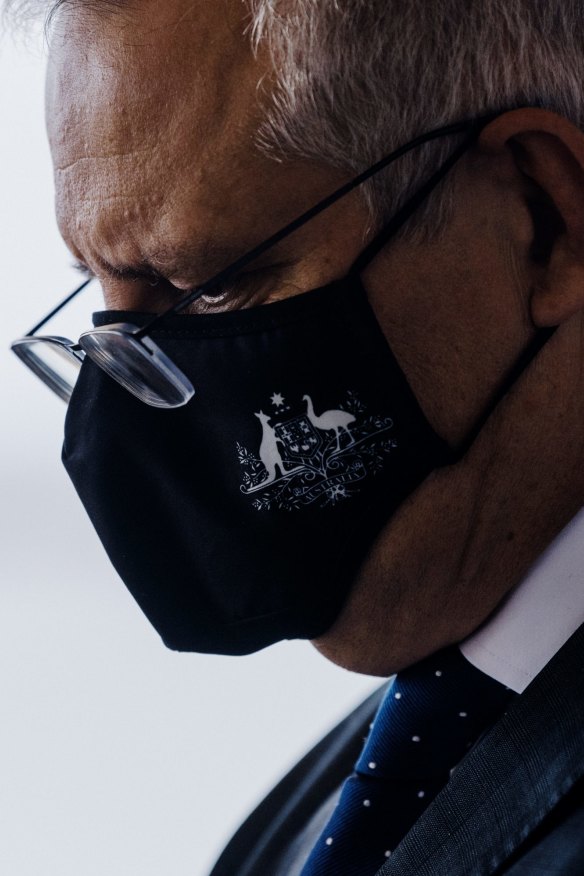
While Morrison acted swiftly at the outset of COVID-19, he lapsed into complacency where the vaccine rollout was concerned.Credit: James Brickwood
Morrison told this masthead that every Australian PM had made mistakes, but few had repeated the same mistake. And, for a while, it seemed he had indeed learned.
The people showed their appreciation in the manner that prime ministers appreciate most – by expressing their support in the polls. About seven of every 10 Australians told Newspoll they approved of Morrison’s performance, the highest of any PM since Kevin Rudd’s 2008 peak.
Morrison’s triumph was Anthony Albanese’s trial. He suspended the series of “headland” speeches he’d been giving. No one was interested. The Labor leader describes his dilemma at the time: “In an era when the chief health officers of the ACT, NSW, Victoria and Queensland were having their daily press conferences covered live on commercial TV, the only way an opposition leader could get any prominence was to oppose.
“So, the choice I had to make was to be constructive in a national emergency or to chase a higher profile by opposing the government. I chose that I was going to be me, to do the right thing by the country and have enough faith that would be the right thing politically.”
Albanese’s Labor took up a constructive stance. It did not vote against any of Morrison’s substantive COVID-related bills. And he held his nerve as pressure built.
Frustrated Labor MPs grumbled to reporters in the Canberra press gallery that Albanese needed to “put the gloves on” and take the fight to Morrison; Labor worthies wrote angst-ridden op-ed pieces about the party’s irrelevance.
Signs of discontent emerged in the Labor caucus. Bill Shorten said Labor shouldn’t try to win with a “tiny” policy agenda. Tanya Plibersek wrote an op-ed setting out her vision for Australia. Joel Fitzgibbon resigned from the shadow cabinet over climate change policy convinced Labor would lose, and refusing to rule out a challenge against his leader.
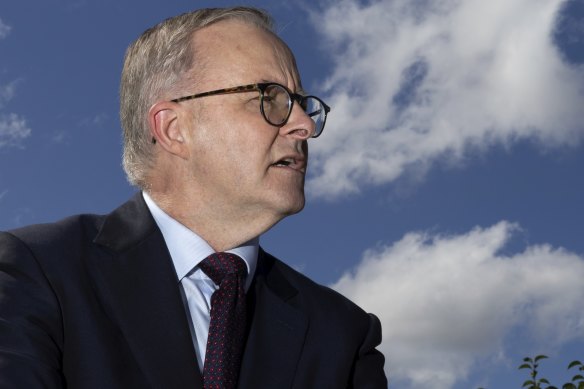
Anthony Albanese held his nerve as Morrison faltered.Credit: Alex Ellinghausen
Every now and then, Albanese was forced to deny rumours of an imminent challenge when speculation became heated: “My leadership is secure.” It turned out he was right. “I was very confident I had a strong support base because I had built it over a long period of time,” he says today. His closest caucus allies attest that the number of names on the list of Albanese opponents never reached double digits in a party room of almost 100.
It might have gone wrong, badly, says Deputy Labor leader and now Defence Minister Richard Marles. The party was able to get through this phase “only because of the strategy” that Albanese had conceived in 2019. “It seems trite to say it but strategy is everything. It was the first time in six years that Labor had had a strategy, something that looked beyond winning the day” – an implicit criticism of Bill Shorten’s time as leader. “It was only because of the strategy that we were able to sustain ourselves in 2020-21,” says Marles.
Two bad habits
At the outset of the pandemic, Morrison warned the country that it could last for as long as six months. If only.
Albanese’s nerve held; Morrison’s resolve did not. As the health emergency wore on, Morrison’s government lapsed into two bad habits. Discipline and policy gave way to complacency and politics.
The failure to secure enough vaccine fast enough was probably the most important example of complacency. Morrison was denounced for saying that the vaccine rollout was “not a race”. But the author of that phrase was the chief medical officer, Brendan Murphy. And he was in charge of the vaccine decisions inside the Health Department.
Other officials say Murphy lacked any real urgency because he said he wanted to see how the various vaccines performed in other countries before deciding for Australia. So, for instance, while the US and UK signed advance purchase agreements for vaccines with AstraZeneca in May 2020, Australia signed its agreement with the company in December – seven months later.
And while the US, UK and Japan signed contracts with Pfizer in July 2020, the Australian government signed its first contract with the firm in November – four months later.
Worse, Pfizer executives had to chase a lethargic Morrison government to get it to agree to meetings to discuss potential vaccine supply. Official correspondence reported by this masthead’s Rachel Clun shows that the Health Department took 10 days to act on Pfizer’s offer of a meeting, and another three weeks before Hunt sent office staff to meet the company.
Israel’s then-prime minister Benjamin Netanyahu famously phoned Pfizer’s global chief executive on 30 separate occasions to secure vaccines for his people. In Australia’s case, it took Pfizer 35 days to get in the door to see the health minister’s staff, and even then the minister himself would not see the vaccine manufacturer’s executives.
Did this complacency delay Australia’s national vaccination? If so, it would have made Australia’s lockdowns unnecessarily long. And it would have extended and aggravated the pressures on the health system.
The Labor minister who replaced Hunt, Mark Butler, commissioned the eminent public health official Jane Halton, an Australian of global standing, to investigate and report on the vaccine rollout. She had full access to all records and officials.
The government published the first section of her report only. In the unpublished section, Halton states plainly that Australia signed vaccine supply contracts “later than comparable countries, and that delayed the rollout”.
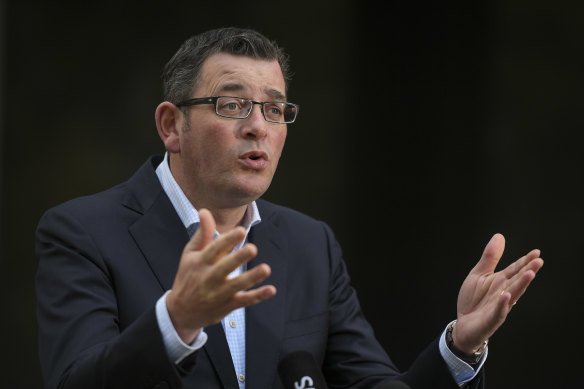
Victorian Premier Dan Andrews at one of his many COVID press conferences.Credit: Eddie Jim
And politics? It was on regular display as Morrison and the premiers increasingly competed for control of policy and credit for successes. One example was the near-constant tension between the federal government and Victorian premier Daniel Andrews.
“Melbourne has gone from the world’s most liveable city to the world’s most locked-down city,” Frydenberg fumed. Victorians, unemployed and depressed, had taken their lives because of unnecessary restrictions, he alleged. Unhappy, Andrews fired back: “All he does is play politics, every day … Victorians want their family protected, they wanted their health issues dealt with so we can open up … He’s not a leader, he’s just a Liberal”.
Frydenberg’s anti-Andrews campaign won him the admiration of libertarians and vaccine sceptics and some of his colleagues. But it cost him votes where he needed them most – in his own seat. “He didn’t appreciate how angry people in Kooyong were with him over lockdown,” explains Ryan. “Victorians had done it really tough, it was a significant sacrifice. People thought the federal government was disrespecting their sacrifice. I had lifelong Liberals saying to me, ‘That’s it!’ They thought he’d turned on his own people.”
NSW Premier Dominic Perrottet, a Liberal, also found Frydenberg and Morrison frustrating. In July last year, Perrottet, the state’s treasurer at the time, decided to increase COVID support payments. There were gaps in the post-JobKeeper system and he wanted them filled. He asked Frydenberg for the Commonwealth to pay half. The federal treasurer said no.
“I was incredibly frustrated,” says Perrottet. In an exclusive interview with The Sun-Herald he demanded Morrison reinstate the JobKeeper payment, and two days later wrote an op-ed in The Daily Telegraph. He got the federal money, after a phone call in which Morrison swore at him for writing the article.
“I was disappointed because I was doing what was necessary to get businesses through, and federal support wasn’t there until political pressure built.”
Morrison hated the publicity and embarrassment. But he responded to them.
But it was in Western Australia that the federal-state scrapping was most costly for the Morrison government. Barnaby Joyce got a bit carried away attacking the state’s strict border closure. “What’s McGowan going to do next? Get his own air force? Have his own army? Maybe he can develop his own currency … It’s kind of ridiculous. This is starting to smell like arrogance and not logic.
“Ultimately, unless you are going to really turn yourself into a hermit kingdom, like we’ll have North Korea and a kind of another hermit kingdom on the west coast of Australia, then COVID is going to arrive.”
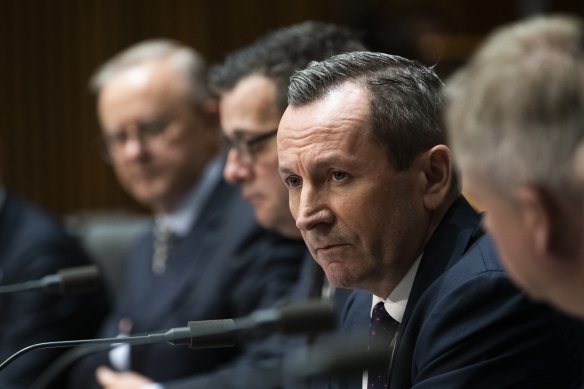
West Australian Premier Mark McGowan stood his ground in national cabinet.Credit: Rhett Wyman
Premier Mark McGowan responded: “We don’t live in a cave, we’re not North Korea, and anyone paying any attention at all would appreciate the remarkable quality of life we’re able to enjoy here.”
It wasn’t clever politics for the federal government to attack the most popular politician in the country in a notably home-proud state. Privately, Morrison and his WA lieutenant Ben Morton’s view was the Coalition had been badly damaged by the decision to join Clive Palmer’s High Court case against the state’s closed border. The pair twigged to the danger quickly and pulled the Commonwealth out of the case on August 2, but the damage was done. West Australians remembered when the 2022 federal election arrived.
The beginning of the end
It happened that from the week that Frewen was announced as coordinator-general of the vaccine taskforce on June 4, 2021, the Coalition’s share of the vote went into a decline that the prime minister could never arrest.
Frewen salvaged the rollout but the percentage of Australians who’d been fully vaccinated that month was just 6 per cent. In the US and UK it was 49 per cent, and in Israel, 56 per cent.
Australia was restless and discontented with the vaccine rollout and the failure of hotel quarantine. “Morrison got COVID credit in 2020 and lost it in 2021,” says a senior Liberal strategist. And that was compounded by distress
over climate change.
“After December 2021, our primary vote crashed and we never got back above 40 per cent [in internal Liberal party polling],” says a former Morrison minister, who had been briefed on internal research. “Climate and the environment were the number-one issue in our polling at the end of 2021.”
From the outset of his time as Labor leader, Albanese had said he would be patient and “kick with the wind in the fourth quarter”. The fourth quarter was approaching and the wind was blowing his way.
This is the second of a three-part series examining the Morrison years. Parts two and three are available to subscribers only. You can sign up at subscribe.smh.com.au/ or subscribe.theage.com.au/.
Cut through the noise of federal politics with news, views and expert analysis from Jacqueline Maley. Subscribers can sign up to our weekly Inside Politics newsletter here.